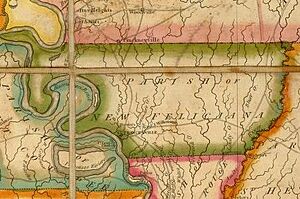Feliciana Parish, Louisiana facts for kids
Feliciana Parish was an important area in Louisiana's history. It was a "parish," which is like a county in other states. This parish was created in 1810 from land that used to be part of West Florida. Because more and more people moved there, Feliciana Parish was split into two smaller parishes in 1824: East Feliciana Parish and West Feliciana Parish.
The name Feliciana comes from a Spanish word meaning "happy land." This area was once part of French La Louisiane. French settlers began living here around 1775. During the American Revolutionary War, Spain took control of the area. The Spanish Governor, Bernardo de Gálvez, named it. He named it in honor of his wife, Marie Félicité St. Maxent, whom he married in 1777.
The town of Jackson was founded in 1815. It became the main town and "seat of justice" for Feliciana Parish. This was before the parish was divided. Jackson was also a center for land sales and learning. People say the town was first called Bear Corners. This was because many wild black bears crossed Thompson's Creek nearby. Later, American settlers named it after General Andrew Jackson. He supposedly camped there with his soldiers after the Battle of New Orleans in 1812.
Contents
History of Feliciana Parish
When Europeans first arrived, Tunica Indians lived in this area. They had moved here and replaced the native Houma people. Later, the Spanish explored and claimed the land. The French also explored the area. In 1682, LaSalle explored the Mississippi River. He claimed all the lands drained by it for King Louis XIV of France.
Changes in Control
In 1763, the French and Indian War ended. Spain gave Florida to Great Britain. In return, Spain gained rights in Cuba. France lost the war and gave Louisiana and the Isle of Orleans to Spain. France also gave land east of the Mississippi River to Britain. The area that is now East and West Feliciana became part of Britain's West Florida colony.
Britain encouraged people to move to West Florida by offering land grants. Many settlers came from the English colonies or from Great Britain. By 1775, many Loyalists moved here from the British colonies. These were colonists who stayed loyal to Britain during the American Revolution. They built large sugar cane farms called plantations. These farms relied on the forced labor of hundreds of enslaved African Americans.
Spanish Control Returns
Bernardo de Gálvez, the Spanish Governor of Spanish Luisiana, gathered soldiers. He led surprise attacks and captured Fort Bute and Baton Rouge. Both places quickly surrendered. Galvez also captured Natchez, Mobile, and Pensacola from the British.
At the end of the American Revolutionary War, Spain got back both the West and East Florida colonies. So, the part of today's Louisiana that is east of the Mississippi River and north of Lake Pontchartrain was under Spanish control. This lasted from about 1780 until 1810.
The Louisiana Purchase and West Florida
In 1800, Spain had to give Louisiana back to France. After a failed attempt to regain control of Haiti, Napoleon sold Louisiana to the United States in 1803. This huge land deal was called the Louisiana Purchase.
However, the West Florida section of what is now Louisiana was not clearly included. The Louisiana Purchase was unclear about its eastern border. President Jefferson said this area was American, but Spain disagreed. Spain continued to control it. Since the 1760s, the eastern border of West Florida had been the Apalachicola River, and Pensacola was its capital.
Republic of West Florida
The colonists in Feliciana were not happy under Spanish rule. In 1810, they rebelled and created their own short-lived country called the Republic of West Florida. They asked President James Madison to make their area part of the United States. Their wish was granted. In October 1810, the Florida Parishes area was declared part of the Louisiana Purchase and an American possession.
The United States first created "Feliciana County" as part of the Territory of Orleans. Later, this county was divided into four parishes: New Feliciana, East Baton Rouge, St. Helena, and St. Tammany. In 1812, Louisiana became a state, and Feliciana Parish was included.
Dividing Feliciana Parish
People in the western part of Feliciana Parish found it hard to travel to Jackson. Jackson was the main town, or "parish seat," in the eastern section. This was especially true during bad weather. To solve this problem, the state legislature divided the area in 1824. It was split into East and West Feliciana parishes. This also recognized that the population in the area had grown a lot. At that time, two new parish seats were chosen: Clinton for East Feliciana and St. Francisville for West Feliciana.
Adjacent Parishes and Counties
- Wilkinson County, Mississippi (north)
- Amite County, Mississippi (northeast)
- St. Helena Parish (east)
- East Baton Rouge Parish (south)
- Pointe Coupee Parish (west)
- Avoyelles Parish (northwest)
- Concordia Parish (northwest)


